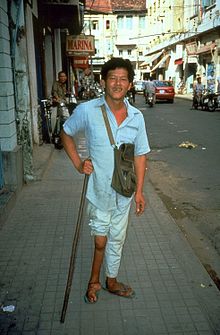| Polio | |
|---|---|
| Other names | Poliomyelitis, infantile paralysis, Heine–Medin disease |
 | |
| A man with a wasted right leg due to poliomyelitis | |
| Pronunciation | |
| Specialty | Neurology, infectious disease |
| Symptoms | Fever, sore throat[1] |
| Complications | Muscle weakness resulting in paralysis;[1] Post-polio syndrome[2] |
| Types | Wild PV types 1,2 & 3; vaccine-derived PV[1] |
| Causes | Poliovirus spread by fecal–oral route[1] |
| Risk factors | Poor hygiene |
| Diagnostic method | Finding the virus in the feces or antibodies in the blood[1] |
| Prevention | Polio vaccine[3] |
| Treatment | No treatment other than supportive care[3] |
| Frequency | 30 (wild) + 856 (vaccine-derived) in 2022[4] |
Poliomyelitis (/ˌpoʊlioʊˌmaɪəˈlaɪtɪs/ POH-lee-oh-MY-ə-LY-tiss), commonly shortened to polio, is an infectious disease caused by the poliovirus.[1] Approximately 75% of cases are asymptomatic;[5] mild symptoms which can occur include sore throat and fever; in a proportion of cases more severe symptoms develop such as headache, neck stiffness, and paresthesia.[1][3] These symptoms usually pass within one or two weeks. A less common symptom is permanent paralysis, and possible death in extreme cases.[1] Years after recovery, post-polio syndrome may occur, with a slow development of muscle weakness similar to what the person had during the initial infection.[2]
Polio occurs naturally only in humans.[1] It is highly infectious, and is spread from person to person either through fecal–oral transmission[1][6] (e.g. poor hygiene, or by ingestion of food or water contaminated by human feces), or via the oral–oral route. Those who are infected may spread the disease for up to six weeks even if no symptoms are present. The disease may be diagnosed by finding the virus in the feces or detecting antibodies against it in the blood.[1]
Poliomyelitis has existed for thousands of years, with depictions of the disease in ancient art.[1] The disease was first recognized as a distinct condition by the English physician Michael Underwood in 1789,[1][7] and the virus that causes it was first identified in 1909 by the Austrian immunologist Karl Landsteiner.[8][9] Major outbreaks started to occur in the late 19th century in Europe and the United States,[1] and in the 20th century, it became one of the most worrying childhood diseases.[10] Following the introduction of polio vaccines in the 1950s, polio incidence declined rapidly.[1] As of October 2023[update], only Pakistan and Afghanistan remain endemic for wild poliovirus (WPV).[11]
Once infected, there is no specific treatment.[3] The disease can be prevented by the polio vaccine, with multiple doses required for lifelong protection.[3] There are two broad types of polio vaccine; an injected polio vaccine (IPV) using inactivated poliovirus and an oral polio vaccine (OPV) containing attenuated (weakened) live virus.[1] Through the use of both types of vaccine, incidence of wild polio has decreased from an estimated 350,000 cases in 1988[3] to 30 confirmed cases in 2022, confined to just three countries.[12] In rare cases, the traditional OPV was able to revert to a virulent form. An improved oral vaccine with greater genetic stability (nOPV2) was developed and granted full licensure in December 2023.[13][14]
- ^ a b c d e f g h i j k l m n o p Estivariz, Concepcion F.; Link-Gelles, Ruth; Shimabukuro, Tom (2021). "Chapter 18: Poliomyelitis". In Hall, Elisha; Wodi, A. Patricia; Hamborsky, Jennifer; Morelli, Valerie; Schillie, Sarah (eds.). Epidemiology and Prevention of Vaccine-Preventable Diseases (The Pink Book) (14th ed.). Centers for Disease Control and Prevention (CDC, US). Archived from the original on 17 March 2022..
- ^ a b "Post-Polio Syndrome Fact Sheet". NIH. 16 April 2014. Archived from the original on 29 July 2011. Retrieved 4 November 2014.
- ^ a b c d e f "Poliomyelitis: Key facts". World Health Organisation. 22 July 2019. Archived from the original on 18 April 2017.
- ^ "This page allows you to request a table with AFP/polio data". WHO. Archived from the original on 2 April 2015. Retrieved 3 May 2023.
- ^ "Disease factsheet about poliomyelitis". European Centre for Disease Prevention and Control. 26 March 2013. Archived from the original on 12 April 2023. Retrieved 12 April 2023.
- ^ CDC (29 March 2022). "What is Polio?". Centers for Disease Control and Prevention. Archived from the original on 14 November 2020. Retrieved 24 April 2022.
- ^ Underwood, Michael (1789). A Treatise on the Diseases of Children. Vol. 2. London, England: J. Mathews. pp. 53–57.
- ^ Daniel TM, Robbins FC, eds. (1999). Polio (1st ed.). Rochester, NY: University of Rochester Press. p. 11. ISBN 978-1-58046-066-8. Archived from the original on 17 June 2016.
- ^ Landsteiner, Karl; Popper, Erwin (1909). "Übertragung der Poliomyelitis acuta auf Affen" [Transmission of Poliomyelitis acuta to monkeys]. Zeitschrift für Immunitätsforschung und experimentelle Therapie [Journal for Research on Immunity and Experimental Therapy] (in German). 2 (4): 377–390. Archived from the original on 9 September 2021. Retrieved 9 September 2021.
- ^ Wheeler DS, Wong HR, Shanley TP, eds. (2009). Science and practice of pediatric critical care medicine. London: Springer. pp. 10–11. ISBN 978-1-84800-921-9. Archived from the original on 17 June 2016.
- ^ "Poliomyelitis". www.who.int. Retrieved 9 August 2024.
- ^ World Health Organization (3 January 2023). "Global Wild Poliovirus 2016 - 2022" (PDF). Global Polio Eradication Initiative – World Health Organization. Archived from the original (PDF) on 8 January 2023. Retrieved 3 May 2023.
- ^ "Polio Vaccine: Vaccine-Derived Poliovirus | CDC". www.cdc.gov. 6 May 2022. Archived from the original on 27 October 2021. Retrieved 27 June 2022.
- ^ Cite error: The named reference
:2was invoked but never defined (see the help page).